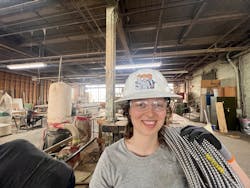The Apprentice’s Guide to NEC Chapter 2
As an electrical apprentice, mastering navigation and interpretation of the National Electrical Code (NEC) will set you apart from your peers and make you an invaluable asset to the boss, customers, and Code enforcement officials. As a master electrician and electrical trainer/instructor for years, here is one of my best pieces of advice: Do not build the bad habit of asking someone else every time you need information from the NEC on a job site. Learn how to do the research yourself!
In this column, it’s time to discuss the purpose of Chapter 2, and see if you know the basics.
NEC Chapter 2 [Wiring and Protection] contains important guidelines that apply “generally” to all electrical installations (see Figure 90.3 for Code arrangement). That means these rules must be applied or affect Articles throughout the entire Code book (Chapters 1-9).
Chapter 2 is typically used during the planning stage of an electrical construction project — before any ground is broken or construction begins. Neatly divided and organized into two different parts (a wiring side and a protection side), it was strategically designed this way to make navigating this massive publication easier. Here are a few Articles to help you remember the title and purpose of the “wiring side” of Chapter 2:
- Art. 230 [Services]
- Art. 215 [Feeders]
- Art. 210 [Branch Circuits]
- Art. 225 [Outside Branch Circuits and Feeders]
- Art. 200 [Use and Identification of Grounded Conductors]
- Art. 220 [Branch-Circuit, Feeder, and Service Load Calculations]
These Articles serve as guidelines for wiring up a building, facility, or dwelling unit.
On the “protection side” of Chapter 2, you’ll find guidelines for the installation of equipment, devices, and wiring intended to prevent damage, electrical shocks, electrocution, ground faults, overcurrents, lightning strikes, short circuits, etc. A few important Articles found in this section include:
- Art. 240 [Overcurrent Protection]
- Art. 250 [Grounding and Bonding]
- Art. 280 [Surge Arresters, Over 1000 Volts]
- Art. 285 [Surge-Protective Devices (SPDs), 1000 Volts or Less]
These Articles serve as guidelines for protecting the building, facility, or dwelling unit you just wired.
Here’s a curveball; some of these articles may fall on both sides of Chapter 2. Can you identify at least two Articles that do just that? Put your answers in the comment box below this article to start an interactive discussion.
It’s simple tricks and exercises like this that will get you well on your way to mastering the Code in no time. Always remember, the NEC is not intended to be a design manual for untrained persons. Practical field experience and training are required to understand most of these requirements. Take your time with learning the NEC; it’s a marathon not a sprint. Even the most savvy Code users needed years to develop a sharp skill in navigating this important document.
Follow my column for more practical how-to articles and tips for applying electric basics concepts in the field. Past columns include Everyday Instructions for Electricians, The Apprentices Guide to Special Equipment, The Apprentice’s Intro Guide to Motors, The Apprentice’s Guide to Service Entrance Cable, and The Apprentice’s Guide to NEC Art. 550. For more information on why a structured approach is so important to navigating the NEC and how to put its requirements into practice in real-world settings, read “The NEC for Newbies.”
Harold De Loach, a master electrician and electrical trainer/instructor, is the founder of The Academy of Industrial Arts (www.taia-school.com) in Philadelphia. With more than 30 years of experience in the field, he writes regular exclusive content for the E-Train and can be reached at [email protected].
About the Author
Harold De Loach
De Loach is the Director of Education and Training for the Leaders of Electrical License Preparation courses for Philadelphia and The Lehigh Valley (www.necprepclass.com). He is the founder and Director of The Academy of Industrial Arts L.L.C. (www.taia-school.com), a customized electrician training program that provides entry-level electrician training courses, electrical safety classes and customized electrical construction courses. He is trained by the National Center for Construction Education and Research (NCCER). He is a member of The National Society of Collegiate Scholars, the Independent Association of Electrical Inspectors, the Electrical Association of Philadelphia, and the Better Business Bureau.
His level of knowledge affords him to teach entry, intermediate, and master level electricians. Armed with more than 20 years of experience in the electrical, general construction, and real estate development industry, he offers his students and clients several unique skill sets. He has worked as the Head Craft Instructor and Assistant Director of Education at the Apprenticeship Training Center (affectionately known as The ABC School) in Harleysville Pennsylvania for Associated Builders and Contractors (The South-Eastern Pa. Chapter). Prior to Joining ABC, he directed a work-readiness (Re-Entry) Construction Technology program within The Philadelphia Prison System and as an Electrical Technician Program instructor at Kaplan Career Institute (Formerly Thompson institute) in Center City Philadelphia and Franklin Mills. He is available for consultation, private tutoring, speaking engagements, or strategic partnerships that can bolster the number of new electricians entering the industry.

